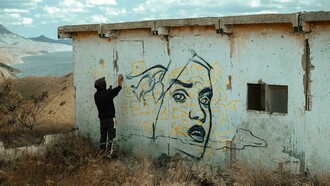There's an eeriness amongst Monika Sosnowska's Structural Exercises whose display evokes a graveyard of detritus from a once busy construction site. There's no mystery here of whether the materials were once or will be soon used. It's all over for them. The trucks have packed up and left these giant discards behind.
All made in 2017 specifically for this show, what unites the works is their distinct lack of usefulness and potential. Taking titles from building materials, particularly those used for assembling foundation structures, they point to the stuff of sturdy resilience, yet in hopeless contrast, offer no such reassurance. Instead, their exaggerated size wincingly accentuates their dumb presence in an immersive theatre of the absurd.
T doesn't even fit the space. Otherwise a sturdy t bar used for creating grided frameworks, this one appears folded and squished against the wall. It's ruined and as useful as a Rachel Whiteread slumped mattress. Neighbouring Rebar 16 spews from the gallery wall. Far from its reinforcement bar origins, this metal collection mimics a comedy of wiring that's escaped from its safety casing or a horse's tail positioned at the arse end of the ass. Nearby, Rebar 12 suspends from the ceiling in a knotty metal mess with no hope of disentanglement.
In this company of strangers, there is little to hold the works together. While a line is often a device for containing a composition, here in Rebar 20 it splits horizontally across the room with all the accuracy of a small child's drawing, directing us from nowhere in particular to somewhere else. It has failed its potential. Likewise the split apart Pipe could perhaps be rolled to fit back together, though being metal, there's no chance of this happening. It will remain undone like pencil shaving rubbish.
This is a behind the scenes of behind the scenes. Unlike much of Sosnowska's previous work which explores the space, the built structure and its parts, here is a story of the building blocks of the building blocks. These discombobulations reveal that the demise of the structure is a sum of its faulty parts. In a drama of upturned foundations, H and Concrete may hint at the root of the problem, though it equally parodies a split licorice strap in a silly hat. As another usurper of the substructure, C and Concrete seems to have cranked a square slab from the gallery floor and left it uselessly mid action. As such, the artist's excavation exposes the faultlines.
Sosnowska draws upon the post WWII cycles of architectural construction and destruction in her Warsaw home town, where communism and capitalism have taken turns to build representations of the ideal society. Claiming that 'architecture arranges, introduces order, reflects political and social systems', she shows us the flipside where burrowing into the building unmasks manipulation and disorder. An unnerving testament which highlights the farcical componentry we depend on. And it seems the more monumental the built environment, the larger the root of the problem, looming over us as our cities seesaw between development and demolition.















